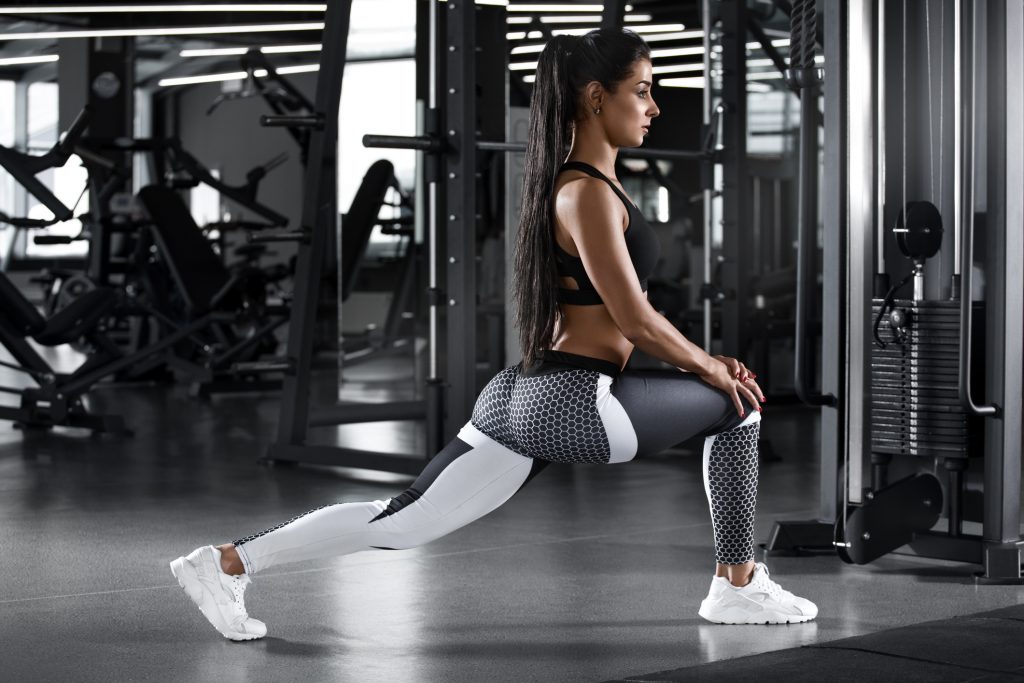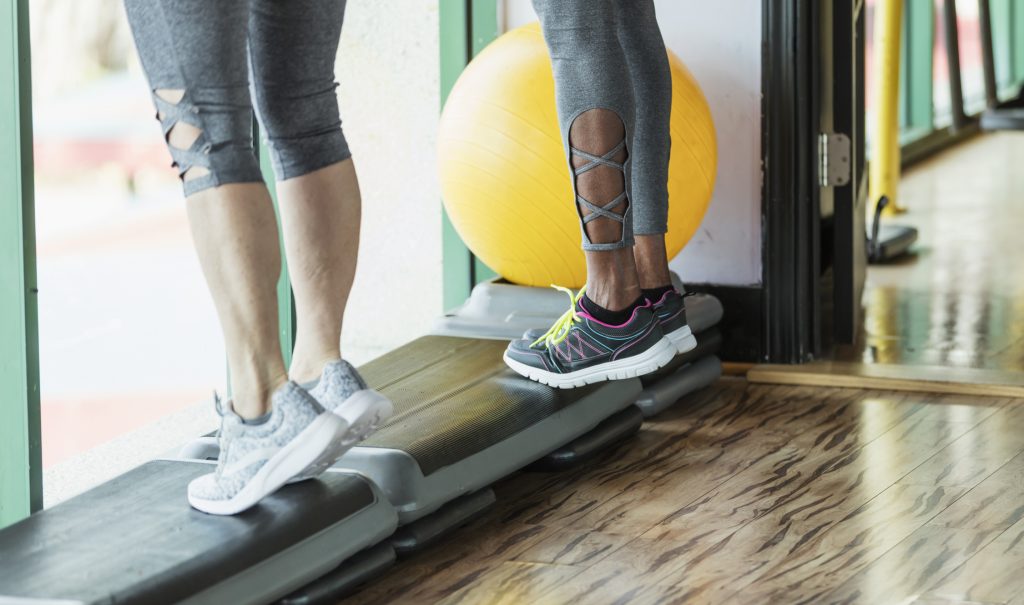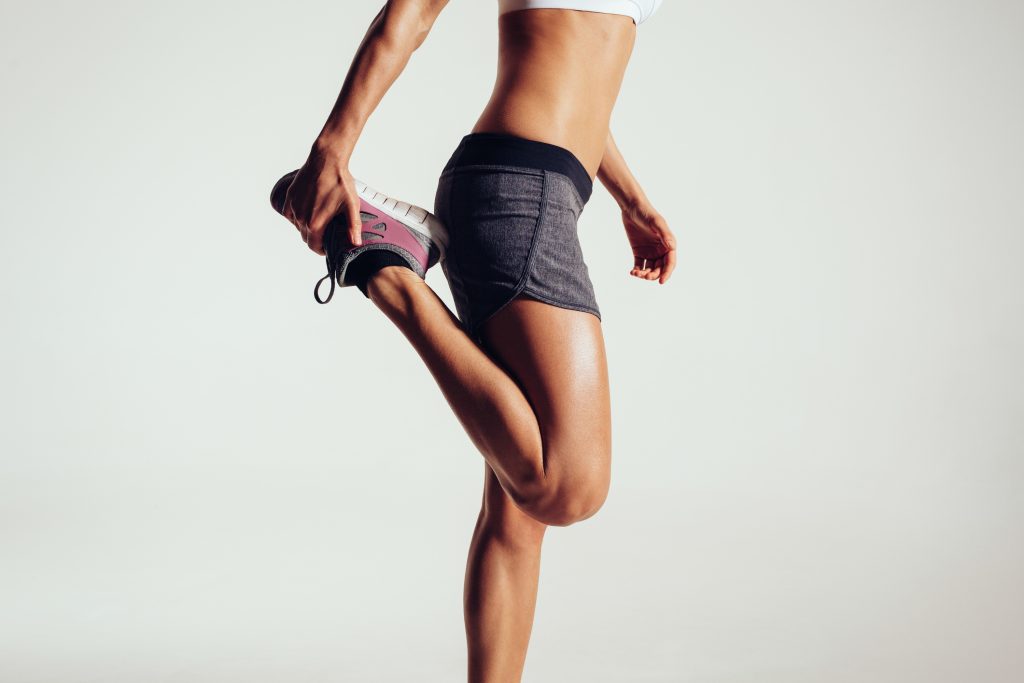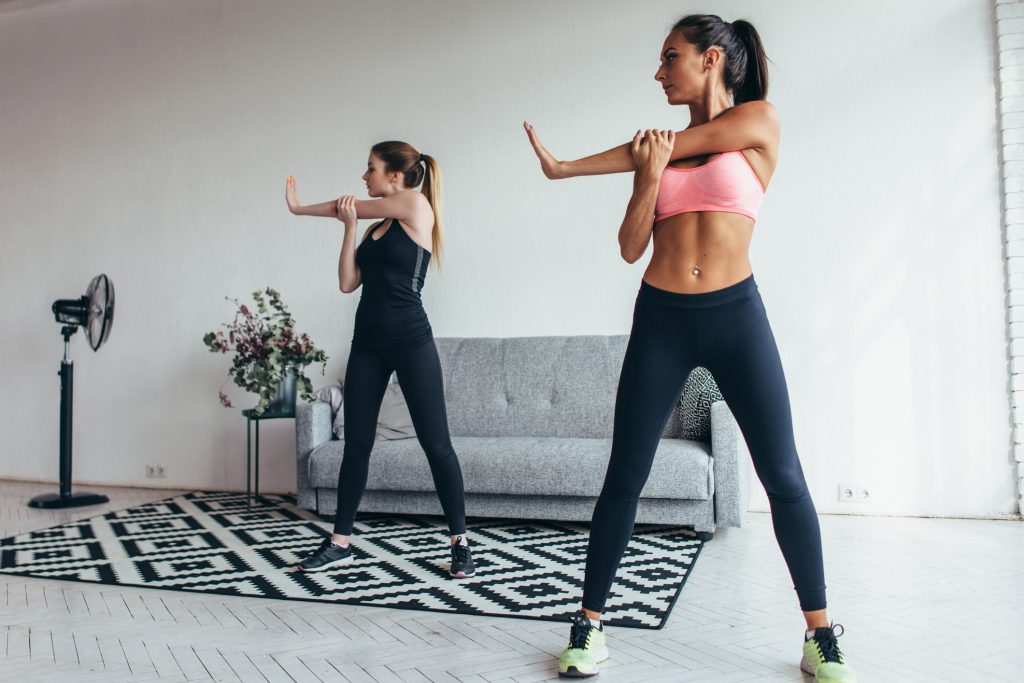Our bodies adapt to our lifestyle, but this can have an adverse effect on our flexibility.
We’ve identified five stretches to improve flexibility in key areas of your body.
Whether you’re trying to improve your own flexibility or your clients’, you’ll be thankful for these stretches.
Before you start, though, there are several things to bear in mind –
- Breathe normally while holding a stretch.
- Don’t lock any of your joints as you stretch; make sure you’re always in control.
- Always move into a stretch smoothly, avoiding jerking motions.
- Warm up with some light jogging or walking before stretching. Your muscles are much more resistant to stretching at colder temperatures, which can lead to injury.
- Be mindful of your form, and don’t stretch beyond your limits.
Lunges

The hips are a common area where people tend to lack flexibility. This is hardly surprising, given how many everyday activities limit our hips’ range of motion. Sitting in an office, driving in a car, and slouching on a sofa are just some examples.
Even some active lifestyles can have this effect. Cycling, for instance, involves sitting still for long periods and performing repetitive movements, which can tighten hip muscles.
Compromised hip mobility forces our bodies to compensate elsewhere – usually in our back. This can lead to injury and chronic pain issues further down the line.
The lunge is ideal for reducing hip stiffness, as it lengthens the supporting muscles and joints to restore our range of motion. It strengthens the hamstrings, quads, glutes, and hip flexors – all of which are crucial for strong flexibility – so they support our body weight correctly.
To perform the lunge
- Begin in a standing position and place your right leg one step forward, and your left leg one step back.
- Bend your right knee to a 90-degree angle and place your hands on top. Make sure you’re facing ahead, and your back is straight.
- From here, press down on your hands to push your hips forward. You should feel your hip, groin, and thigh on your left side tighten.
- Hold the stretch for around 30 seconds.
- Return to your original standing position, switch your leading leg, and repeat.
Advice for fitness instructors
It’s common for beginners to lose their balance while performing a lunge. This is likely due to weaker glute and abdominal muscles.
Therefore, you should instruct them to keep their feet around six inches apart on the horizontal axis, rather than directly in front or behind. This should give them a more solid footing.
Benefits
- Improves posture
- Improves balance
- Lengthens stride
- Increases walking pace
- Reduces back strain
Overhead triceps stretch

Where lack of flexibility is most obvious, and where flexibility is most required, is in our limbs. We don’t fully engage our triceps most of the time – instead, we stuff our hands in our pockets and let our arms swing by our sides. As a result, the muscles can become weak and underutilised, and the joints rigid.
Conversely, bodybuilders and people with intense workout regimes often experience flexibility issues, as localised muscle growth can obstruct a joint’s range of movement. The same is true of excess adipose fat.
Most lifting and reaching comes through the muscles and joints in our arms, shoulders, and back. Therefore, it’s important to keep them mobile to avoid injury. No muscle functions in isolation, and the triceps stretch is great for engaging multiple muscle groups in the upper body.
To perform the overhead triceps stretch
- Stand up straight with your feet shoulder-width apart.
- Raise your right arm upwards and bend it down at the elbow so that your palm is planted at the base of your neck.
- Bring your left hand over to hold your right elbow and gently push downwards.
- Hold for around 30 seconds before switching arms.
Advice for fitness instructors
Novices with limited flexibility are likely to incorporate other muscle groups to offset the difficulty of a stretch.
Look out for clients hyperextending their spine and bowing forwards when performing the overhead triceps stretch. Ensure their back remains straight and upright.
Benefits
- Boosts circulation
- Relieves muscle tension
- Reduces back or shoulder ache
- Minimises chances of pulling a muscle
- Strengthens form
Heel drop stretch

The calves aren’t the first muscle group that comes to mind when we think of improving our flexibility, but they support our entire bodyweight. They essentially inform how the rest of our muscles and joints behave.
Calf tightness can lead to pain, which causes our body to compensate in other areas. This can lead to imbalances and chronic issues like Achilles tendonitis, plantar fasciitis, and more commonplace complaints like shin splints and cramps.
Unless we’re avid ramblers or runners, our calves don’t stretch much beyond walking around the supermarket every week. It’s the same old story, but lack of exercise and sitting at a desk all day are the typical culprits. As a result, we have to go out of our way to fully engage our calf muscles.
The heel drop stretch will not only lengthen your calves’ muscle fibres and alleviate tension, but also engage other muscles and joints.
This is ideal, as the best way to preserve range of motion and flexibility in your joints and muscles is to ensure they’re doing their respective jobs.
To perform the heel drop stretch
- Stand on the balls of your feet on a step, and drop one heel towards the floor. Use a wall for balance.
- Slowly lower your heels below the edge of the step and then raise them back up.
- Repeat for as many reps as feel comfortable. Slowly build up more over time.
Advice for fitness instructors
It may be a good idea to spot for your clients if you’re a PT, to stop them slipping off the step while performing this stretch.
You could even have clients spot for each other if you’re directing a class. It’s not uncommon for clients to lose balance or feel a bit uneasy until they build up the confidence in their own strength.
Benefits
- Prevents cramping
- Alleviates pressure on your knees
- Prevents Achilles Tendinitis
- Prevents shin splints
- Improves walking and running form
Standing thigh stretch

You might wonder how flexible your quads can be, given that they’re positioned between two joints. However, it’s for this exact reason they’re so integral to flexibility and mobility. Your body’s skeletal and musculature systems are all connected and interdependent, so we can’t address flexibility without addressing the core systems supporting it.
Your quadriceps are one of the largest muscles in your body and are involved in nearly every movement of your leg. They work together with your hamstrings, glutes, hips, and back, absorbing impact while walking, running, and jumping, while helping to stabilise and protect your knees.
Any restricted function here has a hefty knock-on effect elsewhere. It could not only lead to compromised knee function, but also cause aches, stiffness, PCL tears, lower back pain and difficulty walking.
Together with the lunge, the standing thigh stretch is a cornerstone stretches to improve flexibility and healthy joints in your lower body.
To perform the standing thigh stretch
- Stand upright.
- Bending your leg at the knee, bring it up behind you so that you’re standing on one leg.
- Hold the top of your foot with your hand and pull your leg up until you feel your quads tighten.
- Hold for 30 seconds.
- Return to your standing position and repeat on the other leg.
Advice for fitness instructors
Because this stretch is familiar to so many people, clients can sometimes perform it a bit hastily, often with poor or hyperextended form. It might be worth reminding them it isn’t necessary to pull the leg as far as they can up their back, only enough to feel a stretch in their quads.
Arching or twisting of the spine can occur if a client struggles to reach their foot with their hand, and should be corrected. You can always assist them with this, while ensuring they maintain good posture.
Benefits
- Alleviates knee strain and reduces chances of injury
- Maintains mobility
- Releases tension in lower back
- Reduces post-workout soreness
- Ensures muscle and joint longevity
Cross arm stretch

Your shoulder joint has the largest range of movement in your body, but it relies on ligaments and muscles to accomplish this rather than the joint itself. This soft tissue is vulnerable to injury, strains and tension arising from prolonged poor posture and stress, while the shoulder joint is prone to hyperextension and dislocation.
Our shoulders have such mobility because we need it. From mowing the lawn to carrying the shopping into the house, they’re involved in most everyday activities. That’s why it’s so integral to preserve their flexibility, and we feel so restricted when we lack it.
The cross-arm stretch keeps the muscles and ligaments supporting your shoulder joint from tightening up too much and becoming inflexible. This keeps tension at bay and helps prevent alignment issues, tendonitis, and carpal tunnel syndrome.
- Begin by standing or sitting upright.
- Bring your right arm across your body, keeping your shoulders level.
- Bring your left arm up over your elbow and squeeze your right arm towards your chest to feel a stretch in your shoulder.
- Hold for 30 seconds and then swap arms.
Advice for fitness instructors
Inexperienced clients tend to pull the stretching arm too far and twist their body, putting stress on the shoulder blade. Ensure their elbow is kept below shoulder height and their shoulders remain level so the stretch is felt on their shoulder joint.
Benefits
- Improves posture
- Relieves muscle tightness
- Prevents neck and shoulder pain
- Improves athletic performance
- Reduces chances of injury/damage to shoulders
Improving flexibility isn’t all about performing contortionist yoga poses. Training for flexibility is all about the preservation of our body’s joints and muscles, so that they’re able to perform their functions comfortably, properly, and with minimal strain for as long as possible.
We’re all born with a full range of motion in our joints and muscles; hopefully the above stretches will see you well on your way to restoring yours.




Leave a Reply